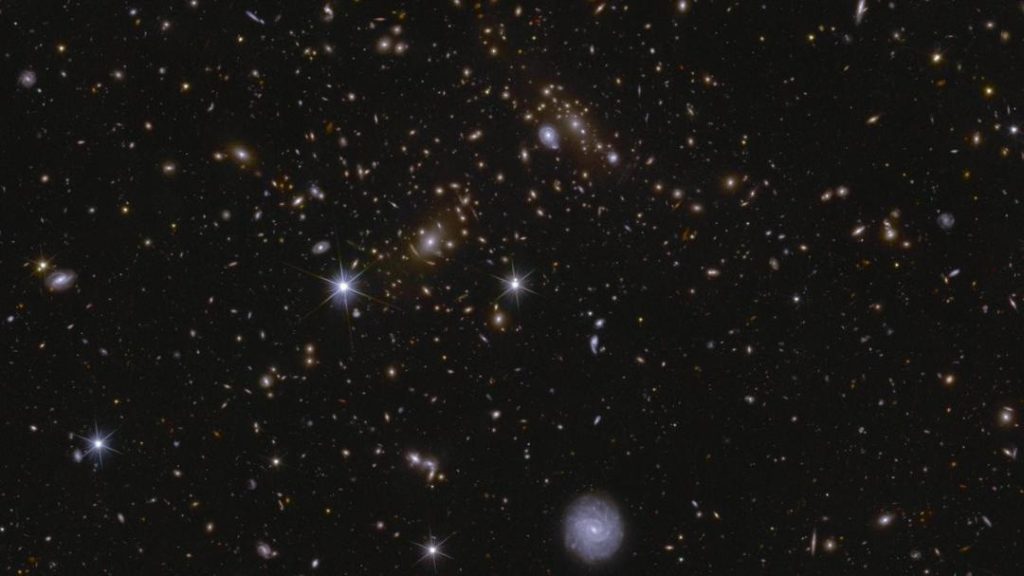
ESA’s Euclid Mission Spots 26 Million Galaxies in First Survey Data Set
The European Space Agency’s (ESA) Euclid mission, designed to explore the composition and evolution of the dark universe, has released its first batch of survey data. This milestone marks a significant step forward in understanding the mysteries of the cosmos. The mission’s primary objective is to study the distribution of galaxies and dark matter, which make up approximately 95% of the universe’s mass-energy budget.
Euclid’s First Survey Data Set: A Treasure Trove of Astronomical Discoveries
The Euclid mission has been observing the sky for just one week, and already, it has spotted an astonishing 26 million galaxies. This is just the beginning, as the mission will eventually provide the deepest observations in its designated areas of study. The survey data set is a treasure trove of astronomical discoveries, offering a glimpse into the deep fields of the universe.
The Euclid mission is equipped with a unique telescope and spectrometer designed to study the distribution of galaxies and dark matter. The spacecraft is currently orbiting the L2 (Lagrange point 2), a gravitationally stable location 1.5 million kilometers from Earth. From this vantage point, Euclid can observe the sky with unparalleled precision, minimizing the interference from Earth’s atmosphere.
The mission’s primary goals include:
- Mapping the distribution of galaxies and galaxy clusters to better understand the evolution of the universe.
- Studying the properties of dark matter and dark energy, which are responsible for the acceleration of the universe’s expansion.
- Investigating the formation and evolution of the first stars and galaxies in the early universe.
The First Batch of Survey Data: A Glimpse into the Deep Fields of the Universe
The first batch of survey data from Euclid provides a fascinating glimpse into the deep fields of the universe. The data set includes observations of three areas in the sky, which will eventually become the mission’s primary targets. These areas are of particular interest due to their high density of galaxies and galaxy clusters.
The Euclid team has been working tirelessly to process and analyze the data, and the initial results are promising. The mission’s unique telescope and spectrometer have allowed scientists to study the distribution of galaxies and dark matter in unprecedented detail.
What Can We Learn from Euclid’s First Survey Data?
The first batch of survey data from Euclid offers a wealth of information about the universe. Some of the key findings include:
- The distribution of galaxies: Euclid’s observations have provided new insights into the distribution of galaxies and galaxy clusters. The data will help scientists understand how these structures have evolved over time.
- Dark matter and dark energy: The mission’s observations will help scientists better understand the properties of dark matter and dark energy. These mysterious entities make up approximately 95% of the universe’s mass-energy budget.
- The formation and evolution of the first stars and galaxies: Euclid’s data will provide new insights into the formation and evolution of the first stars and galaxies in the early universe.
Conclusion
ESA’s Euclid mission has made a significant breakthrough with the release of its first batch of survey data. The mission’s observations have provided a glimpse into the deep fields of the universe, offering new insights into the composition and evolution of the dark universe. As the mission continues to gather data, scientists will be able to further refine their understanding of the universe and its mysteries.
With the Euclid mission, scientists will be able to study the universe in unprecedented detail, gaining insights into the formation and evolution of galaxies, galaxy clusters, and the universe itself. The mission’s findings will have a profound impact on our understanding of the universe, and it will undoubtedly lead to new discoveries and breakthroughs in the field of astronomy.
Source:






